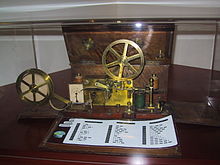History and Categories of Electrical Telegraph
– Electrical telegraphy can be considered the first example of electrical engineering.
– Many different electrical telegraph systems were invented.
– The first category consists of needle telegraphs.
– The first commercial system was the Cooke and Wheatstone telegraph.
– The second category consists of armature systems, such as the Morse system.
Precursors to Electrical Telegraph
– Prior to the electric telegraph, visual systems were used for communication.
– Visual systems included beacons, smoke signals, flag semaphore, and optical telegraphs.
– Auditory predecessors included West African talking drums.
– Yoruba drummers used talking drums to communicate complex messages.
– Messages were communicated over 4-5 mile distances.
Early Experiments in Electrical Telegraphy
– Early experiments in electrical telegraphy were based on electrostatic attraction.
– Georges-Louis Le Sage realized an early electric telegraph with separate wires for each letter of the alphabet.
– Alessandro Volta invented the voltaic pile, providing a continuous current of electricity.
– Samuel Thomas von Sömmering created an electrochemical telegraph in 1809.
– The telegraph employed multiple wires to represent letters and numerals.
Advancements in Electrical Telegraphy
– Hans Christian Ørsted discovered that an electric current produces a magnetic field.
– Johann Schweigger invented the galvanometer as a sensitive indicator for an electric current.
– André-Marie Ampère suggested telegraphy using small magnets under a set of wires.
– Peter Barlow and William Ritchie improved on Ampère’s design.
– William Sturgeon and Joseph Henry improved the electromagnet, increasing magnetic force.
Impact and Decline of Electrical Telegraphy
– Electrical telegraphs were used by railway companies to develop train control systems.
– In the 1840s, the electrical telegraph superseded optical telegraph systems.
– Submarine telegraph cables allowed for rapid communication between continents.
– Electrical telegraph networks had widespread social and economic impacts.
– Manual telegraphy was replaced by teleprinter networks and later by the telephone and the internet. Source: https://en.wikipedia.org/wiki/Electric_telegraph#First_working_systems
Electrical telegraphs were point-to-point text messaging systems, primarily used from the 1840s until the late 20th century. It was the first electrical telecommunications system and the most widely used of a number of early messaging systems called telegraphs, that were devised to communicate text messages quicker than physical transportation. Electrical telegraphy can be considered to be the first example of electrical engineering.



Text telegraphy consisted of two or more geographically separated stations, called telegraph offices. The offices were connected by wires, usually supported overhead on utility poles. Many different electrical telegraph systems were invented, but the ones that became widespread fit into two broad categories. The first category consists of needle telegraphs in which a needle pointer is made to move electromagnetically with an electric current sent down the telegraph line. Early systems used multiple needles requiring multiple wires. The first commercial system, and the most widely used needle telegraph, was the Cooke and Wheatstone telegraph, invented in 1837. The second category consists of armature systems in which the current activates a telegraph sounder which makes a click. The archetype of this category was the Morse system, invented by Samuel Morse in 1838. In 1865, the Morse system became the standard for international communication using a modified code developed for German railways.
Electrical telegraphs were used by the emerging railway companies to develop train control systems, minimizing the chances of trains colliding with each other. This was built around the signalling block system with signal boxes along the line communicating with their neighbouring boxes by telegraphic sounding of single-stroke bells and three-position needle telegraph instruments.
In the 1840s, the electrical telegraph superseded optical telegraph systems, becoming the standard way to send urgent messages. By the latter half of the century, most developed nations had created commercial telegraph networks with local telegraph offices in most cities and towns, allowing the public to send messages called telegrams addressed to any person in the country, for a fee.
Beginning in 1850, submarine telegraph cables allowed for the first rapid communication between continents. Electrical telegraph networks permitted people and commerce to transmit messages across both continents and oceans almost instantly, with widespread social and economic impacts. c. 1894, the electric telegraph led to Guglielmo Marconi's invention of wireless telegraphy, the first means of radiowave telecommunication.
In the early 20th century, manual telegraphy was slowly replaced by teleprinter networks. Increasing use of the telephone pushed telegraphy into a few specialist uses. Use by the general public was mainly special occasion telegram greetings. The rise of the Internet and usage of email in the 1990s largely put an end to dedicated telegraphy networks.
